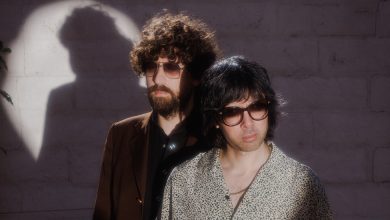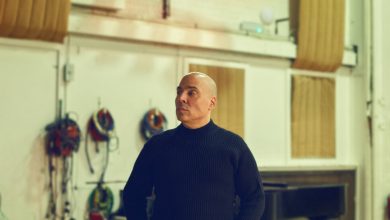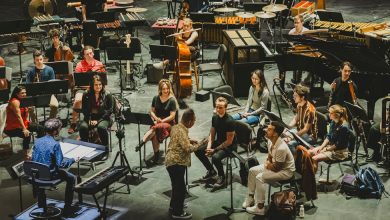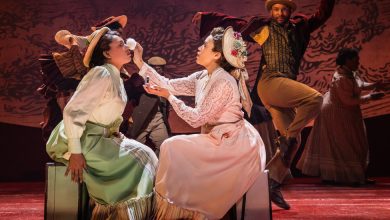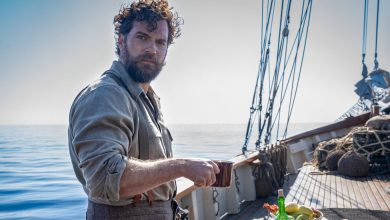‘Sex Education’ Gets More Inclusive in Its Intimacy

Layla (Robyn Holdaway) slides a bin in front of the bedroom door, takes a small wicker box from its hiding place in a drawer full of clothes and opens it to reveal a roll of Ace bandages and a tin of safety pins.
The scene that ensues, from Season 3 of “Sex Education,” depicts a routine that is all too familiar for many nonbinary and transgender youth. Layla — who, like Holdaway, uses they/them pronouns — proceeds to wrap the bandages tightly around their chest, which is already bruised and bloodied from unsafe chest binding.
Later in the episode, Cal — another new and nonbinary character this season, played by the Sudanese American actor Dua Saleh — shows Layla a safer alternative: a chest binder, which is a compression undergarment often made of spandex and nylon.
“I did it for a while with Ace bandages,” Cal tells Layla, who tries on a borrowed chest binder. “Until I nearly broke a rib.”
Layla looks into the mirror, laughs incredulously and says with joy, “It feels so much better.”
Laurie Nunn, the creator of this British dramedy, said that presenting such interactions, matter-of-factly with plenty of detail, is part of the show’s effort “to progress these conversations forward.”
“It felt important to me that we see two nonbinary characters communicating with each other onscreen,” she said in a recent video interview. “It’s not just representation; it’s having as much of it as possible within the scope of the show.”
Over two seasons, “Sex Education” has been widely praised for its frank but sensitive depictions of teen sexuality. In Season 3, now out on Netflix, the series has widened its lens to include more stories about queer relationships, gender presentation, intimacy with a disability and other experiences that rarely are explored on mainstream television.
To do so in an authentic but respectful fashion, the producers use intimacy coordinators and a healthy dose of communication. “The show goes to great lengths to make sure that our actors are as protected as possible,” Nunn said
At the same time, stars like George Robinson, who, like his character Isaac, uses a wheelchair, found themselves serving as both performers and de facto consultants, ensuring that the details and dynamics of their scenes were accurate. “Obviously, he’s playing a character, but it’s making sure that it feels authentic and true to his experience as a disabled actor,” Nunn said.
One such scene unfolds in Episode 4, when a dinner date between Isaac and Maeve (Emma Mackey) turns toward the intimate. Isaac is paralyzed from the chest down, like Robinson. Maeve starts kissing him, then pulls away. “Can …” she whispers, trailing off.
“You want to know what I can feel?” Isaac asks.
“Yeah,” Maeve replies.
“Well, I can’t feel anything below my level of injury,” Isaac says. “If you put your hand on my chest, I’ll show you.”
Isaac was originally conceived as an amputee, but the show’s producers decided to rewrite the role around the disability of whoever landed the part. Isaac is a painter, a brother, a lover and crucially, in Season 2, a jealous deleter of voice mail messages. His sense of humor is laced with cynicism, like Maeve’s.
When asked how it felt to film the dinner date scene, Robinson responded in an email, “The easy and instinctive answer would be to think that in the moment, it felt like a real privilege to be a part of a ‘cultural moment’ type scene like that.
“However, I have realized that in actual fact we (myself, Emma and the creative team) purposefully stayed away from thinking too much about the significance of that scene within the landscape of TV, film and media. We came to the conclusion that in order to make the scene successful, we had to make sure that it worked within the story and for the characters at that time in their relationship.”
Kelly Gordon, a trainer at Enhance the UK, a charity run by disabled people, and Chris Yeates, an outreach and support coordinator at Back Up Trust, a charity that supports people affected by spinal cord injury, consulted on Isaac’s story line. The scene works because it’s not about the fact that Isaac uses a wheelchair. It’s a story about two awkward teenagers, an expression of affection and a burned lasagna.
David Thackeray, an intimacy coordinator, worked on all eight episodes of Season 3, including this scene with Isaac and Maeve. Thackeray choreographs each take as if it were a dance sequence or a fight scene, mapping out physical boundaries with each actor beforehand.
“We’re all sitting together, discussing the scene; we mark out where we’re happy to be touched,” Thackeray said. “Even to sit on George’s lap was like, ‘Are you happy with that?’ You keep that communication going.”
Coordinators and consultants checked in constantly on the cast’s comfort levels. Jodie Mitchell, a consultant who advises productions about how to depict nonbinary characters and themes (and who also uses they/them pronouns), was initially brought on only to work on the script with the writers. Then one of the show’s directors, Runyararo Mapfumo, called, wanting to double check the details of scenes featuring nonbinary characters.
“And then she really wanted me to come on set, which I think is indicative of how much this program really wants to get things right,” Mitchell said in an interview. “It’s not just about posturing for them or ticking the box of like, ‘Oh, we’ve checked it’s OK with someone.’ They really want to follow through to the highest level they can.”
Mitchell worked on set for three days, focusing on nonbinary story lines, mostly consulting on those chest binding scenes involving Layla and Cal. Holdaway, who plays Layla, had the option of having an intimacy coordinator present for every scene.
“But for a few of the scenes around bindings specifically, they were like, ‘Oh, actually, I just want someone who is trans and has lived experience with being trans in the room with me,’” Mitchell said. “So I was there.”
Saleh, who plays Cal and also uses they/them pronouns, was a poet and musician before moving more seriously into acting (their third EP comes out Oct. 22). While Saleh has performed in some transgender- and queer-centric plays (“WAAFRIKA 1-2-3”) and theater groups (20% Theatre Company in Minneapolis), “Sex Education” was their TV debut.
In a past theater production, “we had a lot of intimacy scenes, but we didn’t have a coordinator there,” Saleh said in a video interview last month. “So coming to ‘Sex Ed,’ it felt surprising how thoughtful and careful they were about our bodies, and about the ways that they helped us set boundaries with each other, and say what we weren’t and what we were comfortable with.”
Like others on “Sex Education,” Saleh is a fan of the show as well as a star, and occasionally got caught up in resonant moments this season. Saleh was particularly moved by scenes portraying Eric Effiong (Ncuti Gatwa), a gay Ghanaian-Nigerian character who attends a family wedding in Nigeria. Eric sneaks out of the reception to go instead to an underground club pulsing with color, queerness and gender nonconformity.
“When I was a teenager, if I had seen this show, I wouldn’t have held onto all of the gross feelings about myself, just in me being me,” Saleh said. “I wouldn’t have been as shameful about just existing.”
